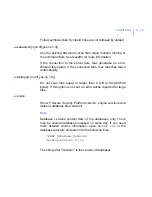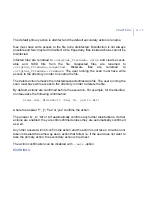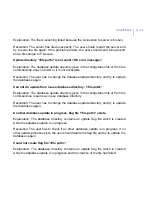
CHAPTER G
G - 9
Show the status of the fsavd scanning daemon and exit. If the
daemon is running, the exit code is zero. Otherwise, the exit
code is non-zero.
NOTE: Usually, a scanning daemon which is not running is not
an error, as fsav launches the daemon before the scan by
default. The daemon that was launched by fsav exits after some
idle time. To run a permanent instance of the scanning daemon,
see fsavd(8).
--suspected-action1={none|report,rename,delete|remove}
Primary action to take when a suspected virus infection is found:
report only (to terminal and as an alert), rename, or delete/
remove.
--suspected-action2={none|report,rename,delete|remove}
Secondary action to take if the primary action fails. Parameters
are the same as for primary action.
--standalone[={on,off,yes,no,1,0}]
Use the standalone version to scan files. The option forces the
launch of a new fsavd.
--stoponfirst[={on,off,yes,no,1,0}]
Stop after finding the first infection with any scan engine. If file
contains multiple infections, only the first is reported. If several
scan engines can detect the infection, only the first one is
reported. By default, the option is disabled.
--symlink[={on,off,yes,no,1,0}]
Summary of Contents for LINUX SECURITY
Page 1: ...F Secure Linux Security...
Page 2: ......
Page 14: ......
Page 28: ......
Page 32: ......
Page 84: ...Note Press ctrl C to cancel your changes 84 F Secure Linux Security Command Line Tools...
Page 150: ...CHAPTERG G 31 For more information see F Secure home page...
Page 166: ...CHAPTERG G 47 dbupdate 8 fsav 1 For more information see F Secure home page...
Page 170: ...CHAPTERG G 51 fsav 1 and fsavd 8 For more information see F Secure home page...
Page 188: ...H 69 H Config Files fsaua_config 70 fssp conf 75...
















































